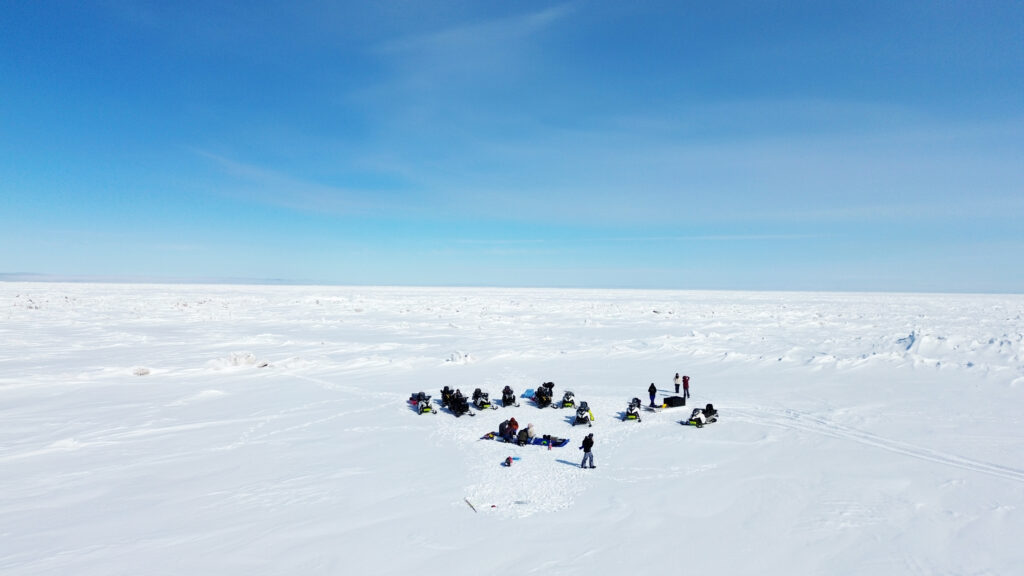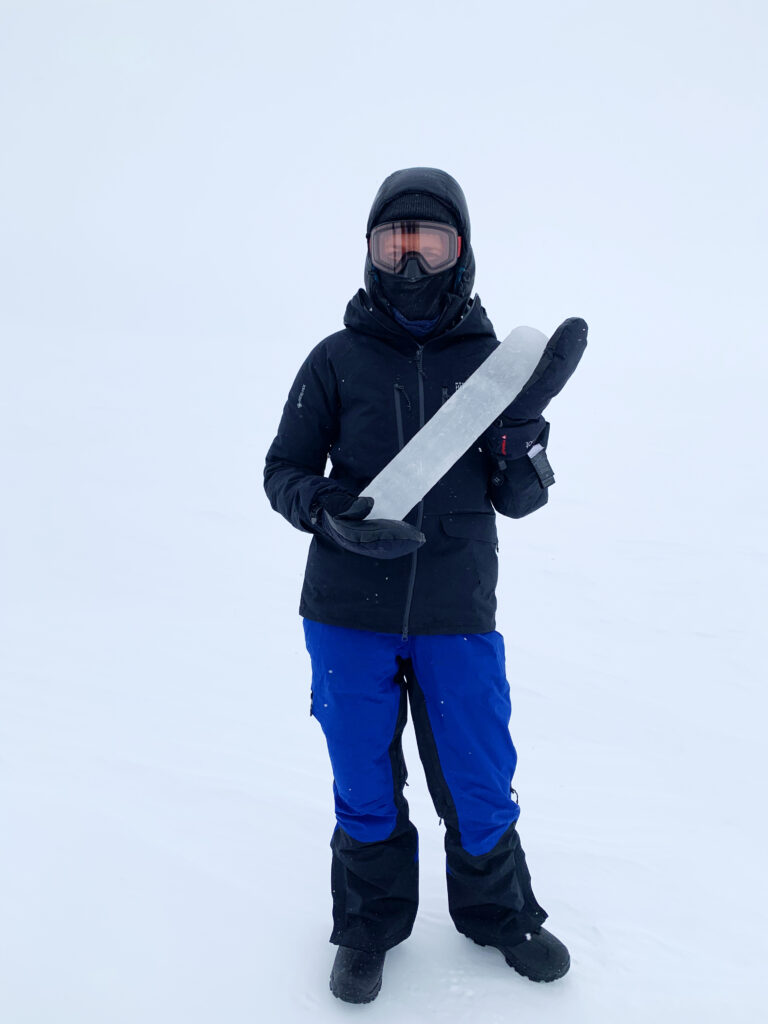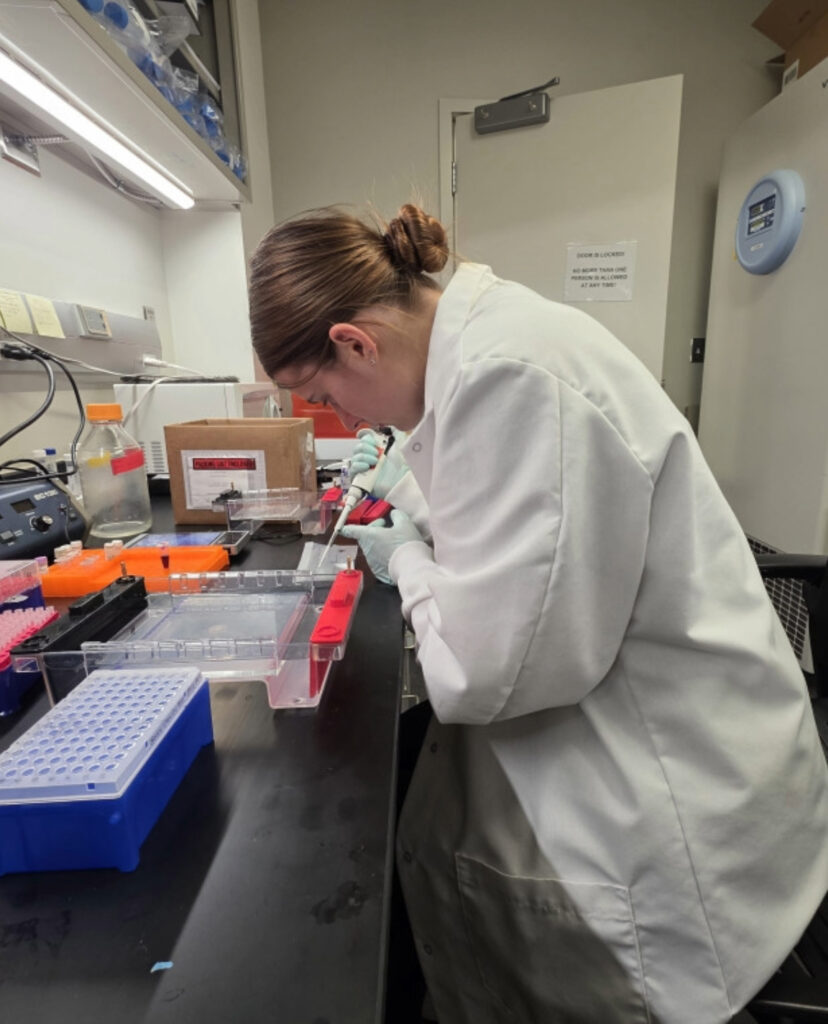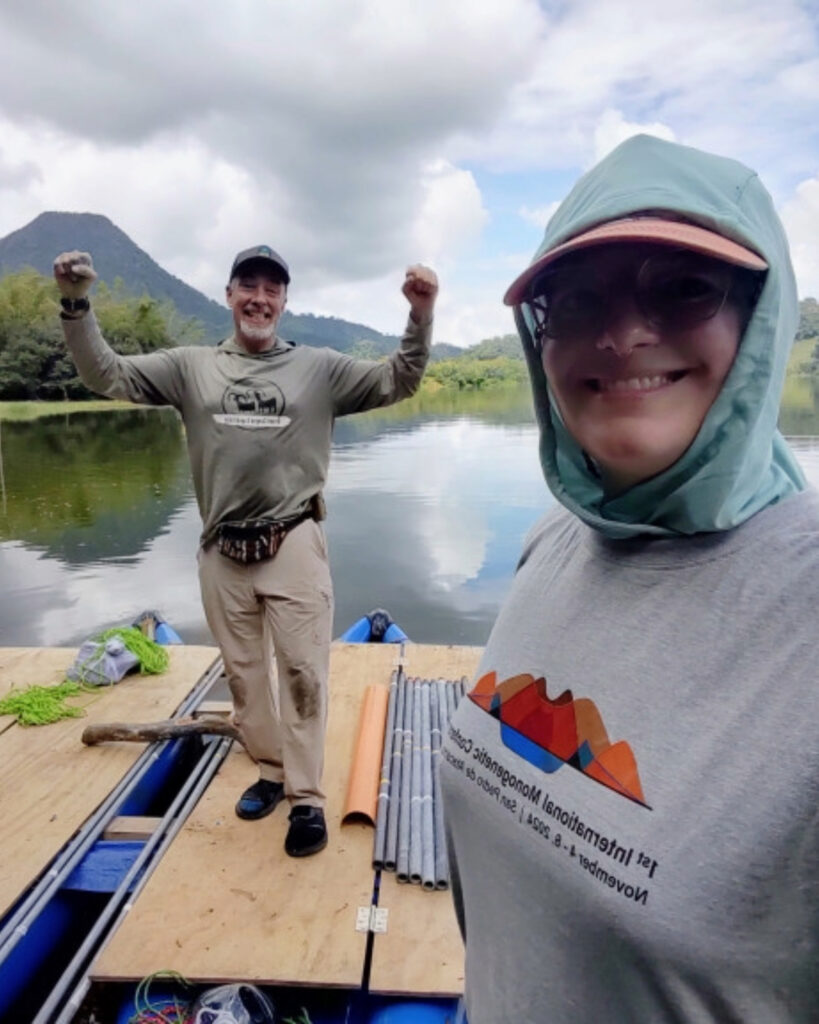Equations on Ice
October 31, 2025
Above: Nash Ward, an undergraduate student in mathematics, drilling his first sea ice core. Credit: Nash Ward
A trip to the Arctic tests mathematical models.
Understanding the intersection of mathematics, physics, biology and environmental science often requires stepping outside of the classroom and into the natural world. For Jody Reimer, assistant professor in the Department of Mathematics and the School of Biological Sciences, and Ken Golden, distinguished professor in the Department of mathematics and adjunct professor in the Department of Biomedical Engineering, this means venturing out into the Arctic where they can study how the physical environment affects life in and on the ice with the help of mathematical models.
In May of 2024, Golden and Reimer co-led a field research trip to Utqiaġvik, Alaska. Though a fairly regular excursion, especially for Golden who has had 19 excursions to the frozen poles of our world, this one was special. The researchers were accompanied by a varied team of mathematics students ranging from high schoolers to Ph.D. candidates, providing them invaluable hands-on experience in the unique and extreme conditions of the Arctic ecosystem. It was an opportunity to test mathematical models and field techniques. It was also a rare chance for students to develop a deeper understanding of polar research.

On the ice
Reimer focuses on how changes in sea ice impact polar bear and seal populations and how these animals respond to those changes. She is also fascinated by the microbes that inhabit the ice itself and the adaptations that allow them to survive in such a harsh environment. Golden’s research focuses on the complex multiscale physical properties of the ice, from modeling macroscale ice floe dynamics down to calculating the porosity and permeability of its microscale brine inclusions. Together, Reimer and Golden are exploring the complex interplay between physics and biology.
This interplay goes far deeper than one might expect, as Golden is able to make ties from astrobiology to military stealth technology and everything in between. He eagerly explains that “The math doesn’t care! It cross-pollinates all over the place. The same mathematics we use to analyze how algae get nutrients from the brine phase can be used to monitor the onset and progress of osteoporosis in human bone!”
This interdisciplinary work is why mathematics research is so critically important. It discovers patterns and correlations that ripple across the scientific community, providing the best possible tools to make new breakthroughs.

Reimer holding a freshly extracted ice core.
The 2024 outing was the largest field team ever led by Golden and Reimer’s first time leading a field research expedition. Because of this, organizing the trip proved to be both a complex task and a valuable learning experience. There was the logistical planning and coordination with university legal teams since students were being introduced to harsh conditions which necessitated every safety protocol possible. The group also needed to acquire land use permits from the local Iñupiat groups of indigenous peoples. Students played a hands-on role in this process, packing equipment and troubleshooting issues in the field. Working with the Barrow Arctic Research Center (BARC), which provided accommodations and some logistical support, the stars were aligned to allow for a successful expedition.
Moving so much equipment across the ice had to be done carefully, especially with the occasional polar bear stopping by to say hello. Once out in the field, these mathematicians braved the Arctic cold in springtime — wind chill dropped to as low as 20° below 0 F on their first day — to carry out experiments linking their mathematical models to real-world observations.
Watching math students immerse themselves in field research was one of Reimer’s favorite parts of the trip. She has earlier explained that “Mathematics isn’t relegated to the realm of puzzles and isolated problems. There’s fundamental and deep connections that affect all regions of life.” Research like this perfectly demonstrates these connections, reinforcing her belief in the value of interdisciplinary integration as a crucial step in advancing applied mathematics.

Microscopic view of ice algae
This integration is especially relevant in the modern day with the advancement of technology which was a major feature of this trip as new programs and equipment could finally be tested. One such highlight was a tool called a PlanktoScope, an open-source and portable imaging device that allows researchers to analyze microbial life in sea ice samples.
More affordable than traditional flow microscopy equipment, this tool allows for broader access to high-quality image data collection. In Reimer’s lab, she and her students have since been analyzing the living organisms in the frozen samples they brought back from the Arctic. A few of these scientists are taking that technological integration a step further, processing the resulting images using AI-based tools that help sort and analyze thousands of microscopic snapshots of life hidden in the ice.
The trip’s success underscores the importance of hands-on fieldwork in mathematical research. Measurements that were collected align with the existing literature and will serve as pilot data for future projects and funding proposals. By blending mathematical modeling with empirical observation, students and faculty alike gain valuable insights into complex environmental systems.
Golden and Reimer have been analyzing the data they collected in the Arctic for a year now and are well on their way planning the next expedition. “We’re laying the groundwork for a broader suite of physical measurements, and ramping up on the biological side of things,” says Golden. This expands on their findings and further explores the intricate relationships between ice, living beings, and the rapidly changing polar marine environment.
Funding for this trip was provided by the National Science Foundation through the Applied Math Research Training Grant. The agency provided funding for two trips with the second planned for next year. And, thanks to the work that’s been done so far, this follow-up expedition is shaping up to be something truly special.
by Izabella Bourland and Michael Jacobsen
This is the cover story of Aftermath, the official publication of the Department of Mathematics at the University of Utah.





 Goldenberg's career coincided with an explosion in structural biology. As Blair notes, "When he was three years old, the first protein structure was solved" — myoglobin, determined by X-ray crystallography and worthy of a Nobel Prize. "When he came here, there were 150 protein structures known. And now, after his 40-year career, there are more than 200,000 protein structures known experimentally."
Goldenberg's career coincided with an explosion in structural biology. As Blair notes, "When he was three years old, the first protein structure was solved" — myoglobin, determined by X-ray crystallography and worthy of a Nobel Prize. "When he came here, there were 150 protein structures known. And now, after his 40-year career, there are more than 200,000 protein structures known experimentally."